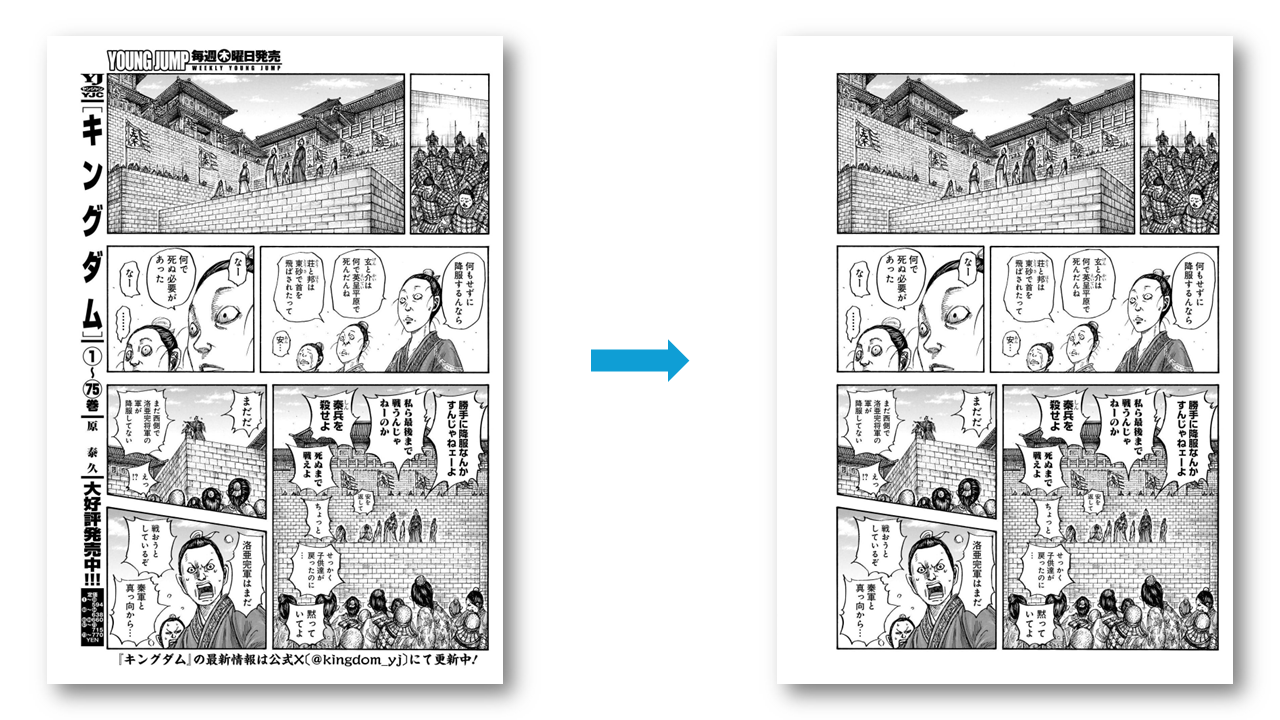In the intricate world of scanlation, where raw manga pages are transformed into readable digital formats for a global audience, attention to detail is paramount. While tasks like translation and typesetting often take center stage, a seemingly minor step cleaning the page borders plays a significant role in achieving a professional and efficient workflow.
Why Clean the Borders? The "Noise" Beyond the Art
When manga pages are sourced, especially from physical magazines, the areas outside the main panels often contain a wealth of information that is entirely irrelevant to the chapter's content. This "border noise" can include:
- Magazine Logos and Headers: Publisher logos, magazine titles, and publication dates.
- Chapter Summaries/Recaps: Textual summaries of previous chapters or introductions to the current one, often in small, dense Japanese text.
- Author/Artist Information: Small bios, contact info, or even personal notes.
- Pagination and Advertising: Page numbers, subtle ad banners, or other non-manga graphics.
- Scanning Artifacts: Dust, smudges, or minor misalignments from the physical scanning process that accumulate in these less "important" areas.
While a human eye can easily distinguish these elements from the actual manga art and dialogue, they become problematic for automated processes, particularly **Optical Character Recognition (OCR)**. If you plan to use OCR to extract text from the raw pages (for example, to assist with translation or create searchable archives), these extraneous textual and graphical elements in the borders can significantly degrade OCR accuracy, leading to garbled output and requiring extensive manual cleanup. By proactively clearing these borders, scanlators ensure cleaner data for subsequent steps.
How to Clean Borders: An Automated Approach with Python
Manually cleaning every page border, especially for long chapters or multiple series, would be incredibly time-consuming. This is where automation shines. Below is a Python script that employs a simple yet effective method to "whiteout" content extending into the border regions of a manga page. This script assumes the central content area is primarily dark lines on a white background, and it seeks out solid white areas near the edges to determine where the "true" page content ends.
The Python Script Explained:
The core idea of the script is to iterate towards the edge from the predefined distance, looking for lines (either horizontal or vertical) that are predominantly white. Once such a line is found, it assumes that everything outward from that line up to the image boundary is "border noise" and fills that area with pure white (RGB 255, 255, 255).
import cv2
import numpy as np
def whiteout_outward_color(img, border_width=275, threshold=0.95):
"""
Whites out content in the outer border areas of a manga page.
Args:
img (np.array): The input image (e.g., from cv2.imread), BGR format.
border_width (int): The initial pixel distance from the edge to start checking.
This acts as a safety margin; the script will search
towards the edge from this point.
threshold (float): The proportion of pixels in a line that must be >= 234
(near white) for that line to be considered a clean break.
Returns:
np.array: The image with border areas whited out.
"""
height, width, _ = img.shape
# Vertical whiteout (Top and Bottom)
# Check from top edge downwards
y_up = border_width
while y_up >= 0: # Iterate towards the top edge
line_pixels = img[y_up, :, :] # Get a horizontal line of pixels
# Check if the line is mostly white (pixel values >= 234)
if np.mean(line_pixels >= 234) >= threshold:
# If it is, whiteout everything above this line
img[0:y_up, :, :] = 255
break
y_up -= 1
# Check from bottom edge upwards
y_down = height - border_width
while y_down < height: # Iterate towards the bottom edge
line_pixels = img[y_down, :, :]
if np.mean(line_pixels >= 234) >= threshold:
img[y_down:height, :, :] = 255
break
y_down += 1
# Horizontal whiteout (Left and Right)
# Check from left edge rightwards
x_left = border_width
while x_left >= 0: # Iterate towards the left edge
line_pixels = img[:, x_left, :] # Get a vertical line of pixels
if np.mean(line_pixels >= 234) >= threshold:
img[:, 0:x_left, :] = 255
break
x_left -= 1
# Check from right edge leftwards
x_right = width - border_width
while x_right < width: # Iterate towards the right edge
line_pixels = img[:, x_right, :]
if np.mean(line_pixels >= 234) >= threshold:
img[:, x_right:width, :] = 255
break
x_right += 1
return img
# Example Usage (assuming you have an image loaded)
# img_path = 'your_manga_page.jpg'
# img = cv2.imread(img_path)
# if img is not None:
# cleaned_img = whiteout_outward_color(img.copy(), border_width=275, threshold=0.95)
# cv2.imwrite('cleaned_manga_page.jpg', cleaned_img)
# else:
# print(f"Error: Could not load image {img_path}")
The `border_width` parameter acts as a starting point for the search. The script will move towards the edge from this distance. The `threshold` parameter (e.g., 0.95) determines how "white" a line needs to be (meaning 95% of its pixels are close to pure white) before it's considered the boundary of the main content. This prevents the script from cutting into actual artwork if a white speech bubble or background extends close to the edge.
Before vs. After: A Clearer Canvas
The visual impact of this process can be subtle at first glance, but becomes evident when you examine the page borders or consider the efficiency gains for OCR. Below are examples demonstrating a manga page before and after applying this border cleaning technique.

Conclusion
While often overlooked, the methodical cleaning of manga page borders is a vital step in producing high-quality scanlations. It eliminates distracting "noise" from the final product and, more critically, optimizes pages for subsequent automated processes like OCR. By leveraging simple yet effective Python scripts, scanlators can streamline their workflow, ensuring that the manga itself remains the sole focus of attention.